Abstract
The use of oxygenated fuels is anticipated to increase over the next decades. This paper reviews the toxicological and exposure information for methyl tertiary-butyl ether (MTBE), a fuel additive, and methanol, a replacement fuel, and discusses the possible health consequences of exposure of the general public to these compounds. For MTBE, the health effects information available is derived almost exclusively from rodent studies, and the exposure data are limited to a few measurements at some service stations. Based on these data, it appears unlikely that the normal population is at high risk of exposure to MTBE vapor. However, in the absence of health and pharmacokinetic data in humans or in nonhuman primates, this conclusion is not strongly supported. Similarly, there are a number of uncertainties to take into consideration in estimating human risk from the use of methanol as a fuel. Although methanol may be toxic to humans at concentrations that overwhelm certain enzymes involved in methanol metabolism, the data available provide little evidence to indicate that exposure to methanol vapors from the use of methanol as a motor vehicle fuel will result in adverse health effects. The uncertainties in this conclusion are based on the lack of information on dose-response relationship at reasonable, projected exposure levels and of studies examining end points of concern in sensitive species. In developing a quantitative risk assessment, more needs to be known about health effects in primates or humans and the range of exposure expected for the general public for both compounds.
Full text
PDF
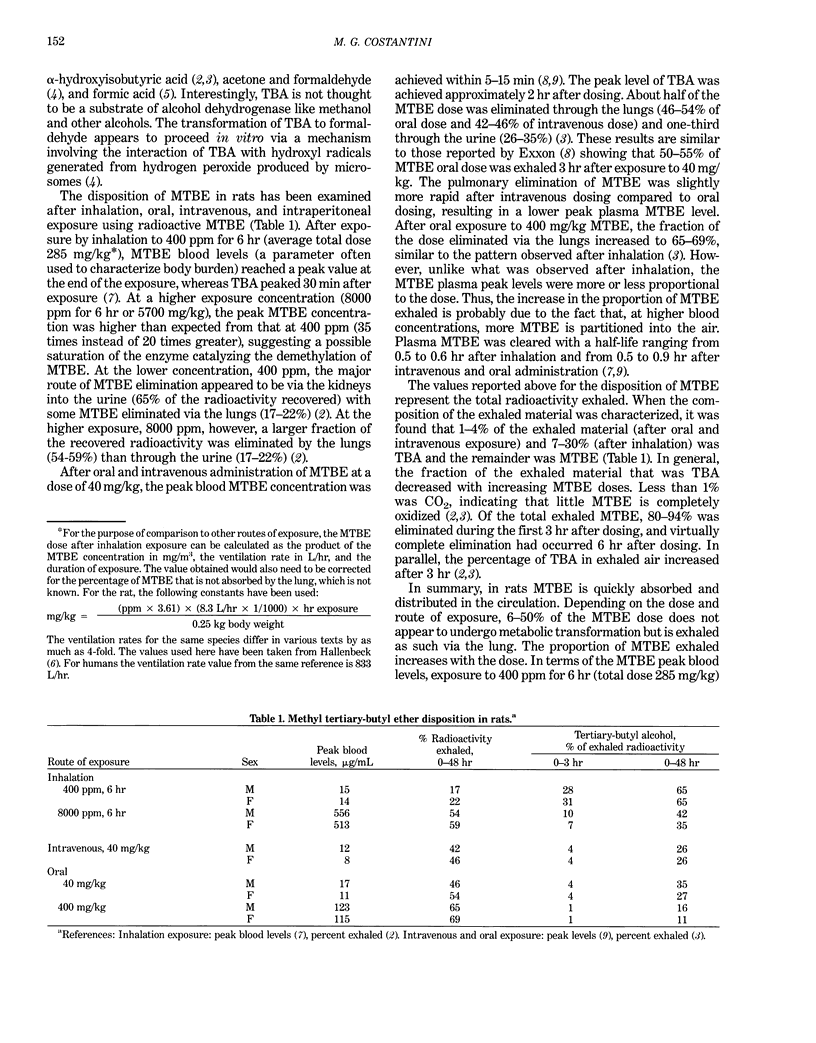
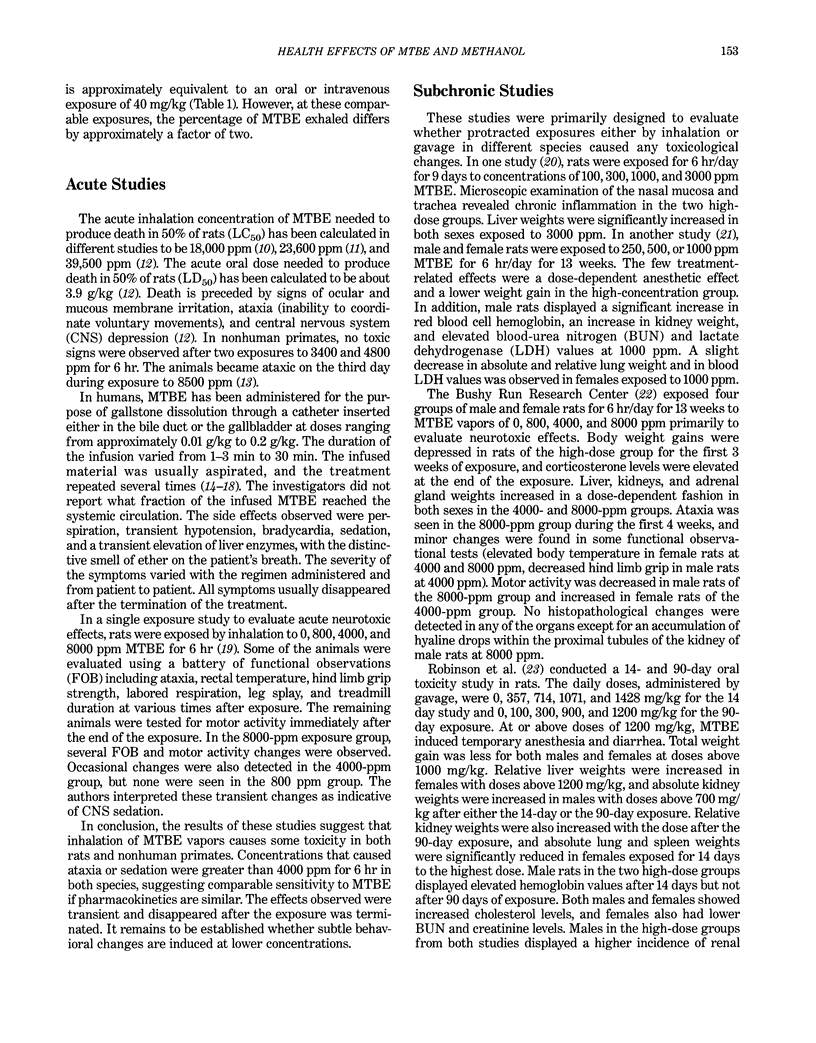
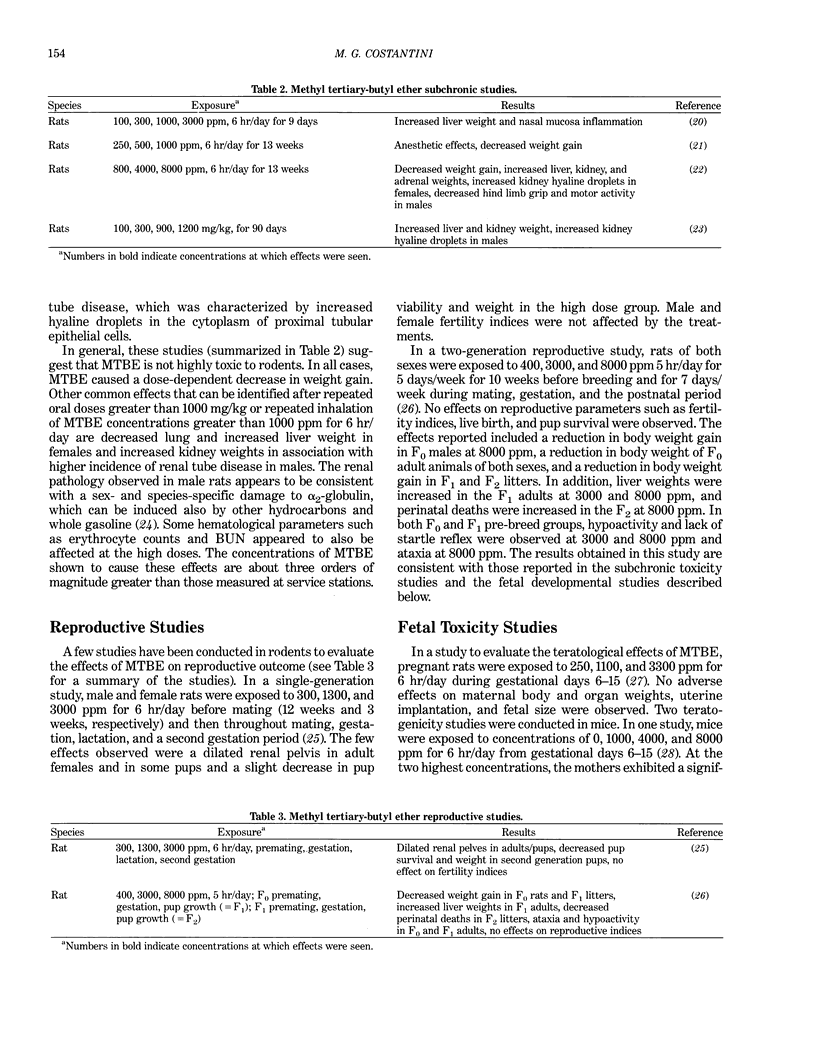
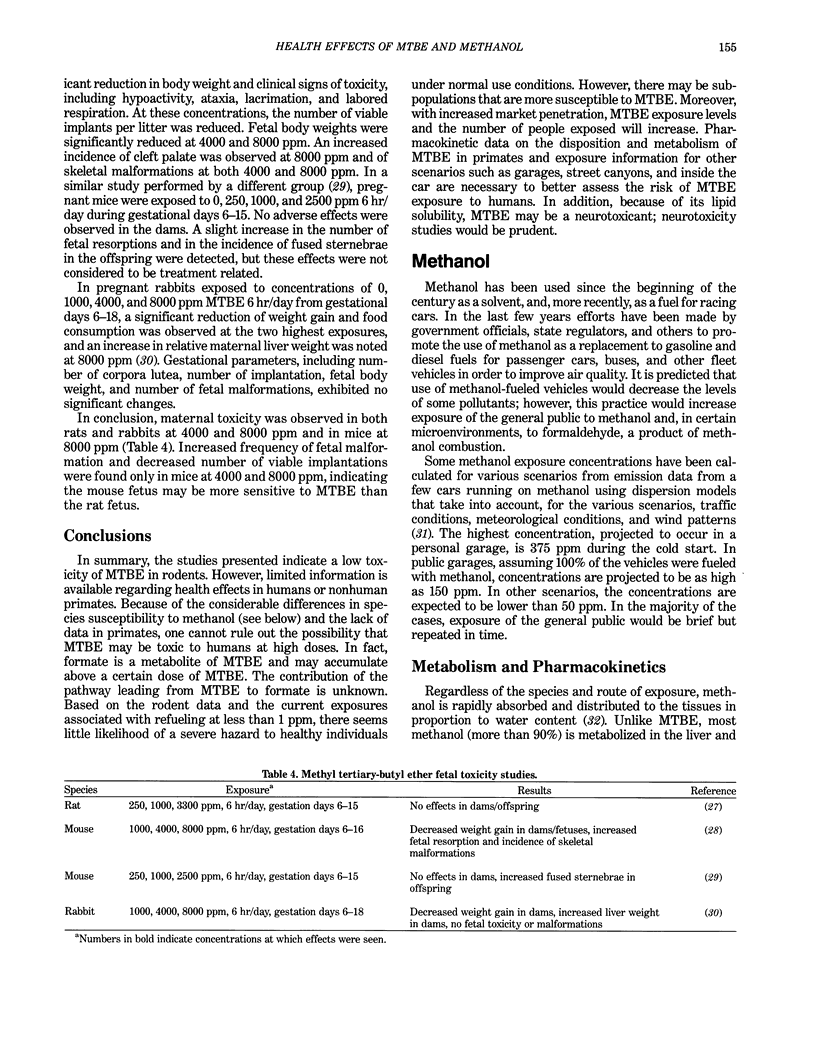
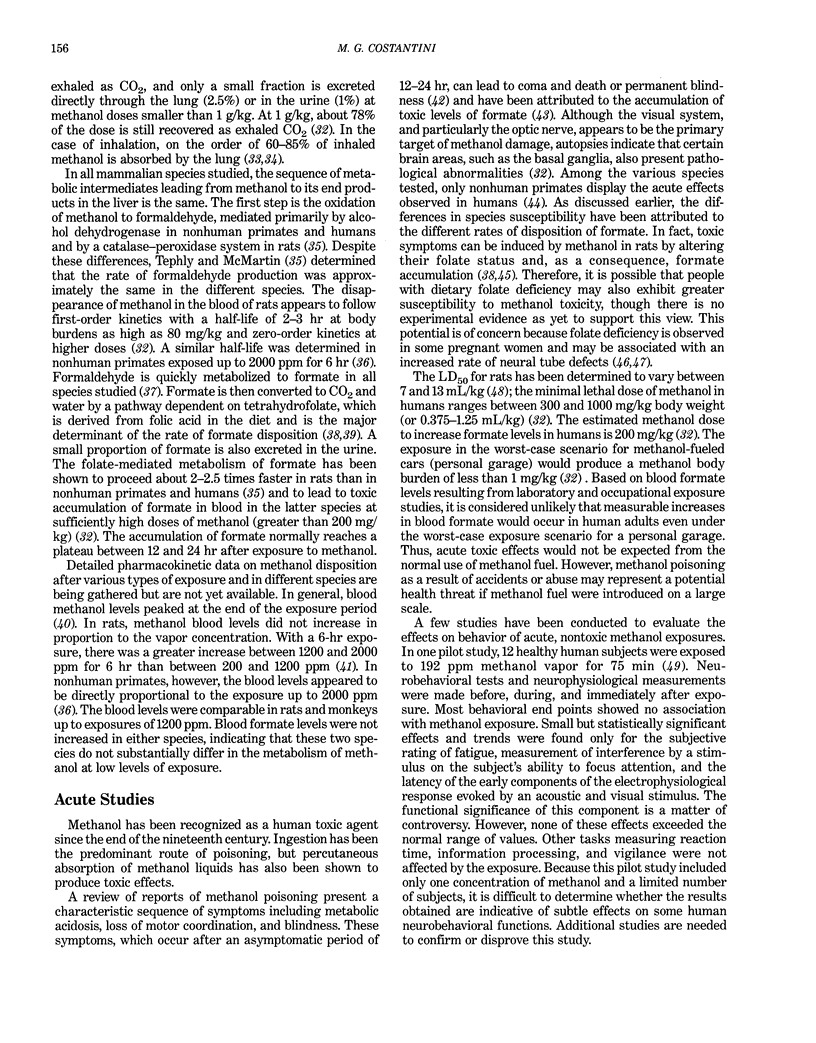
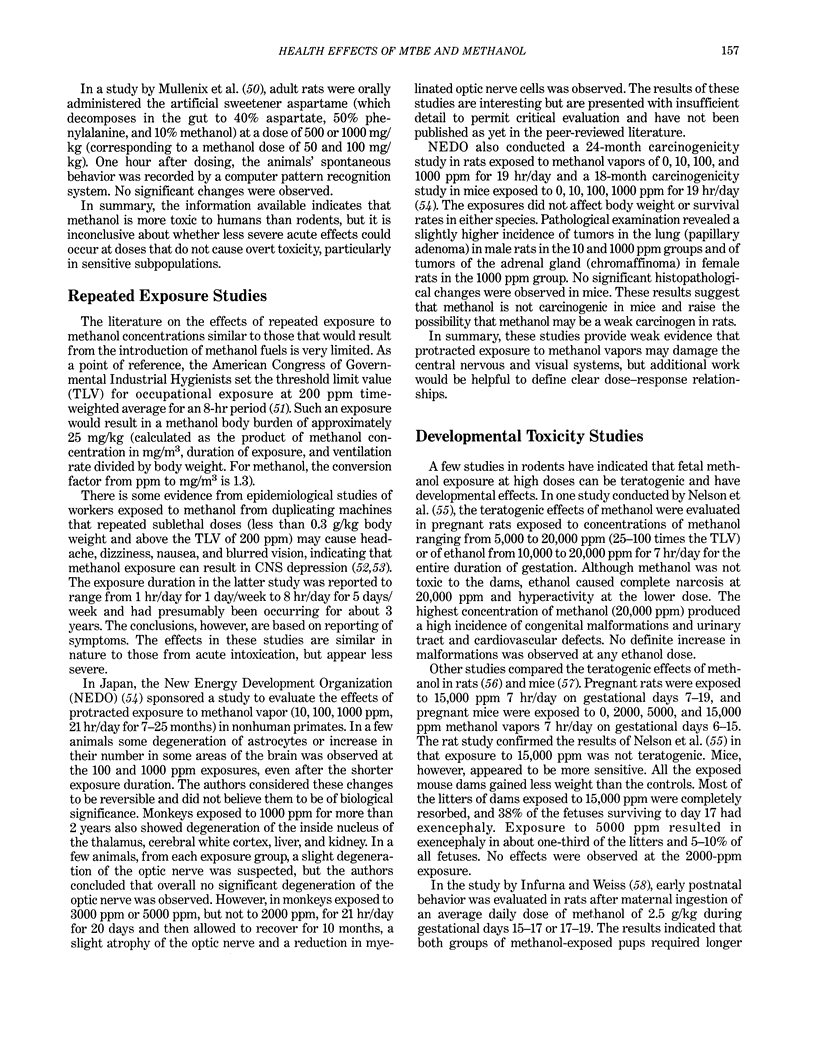
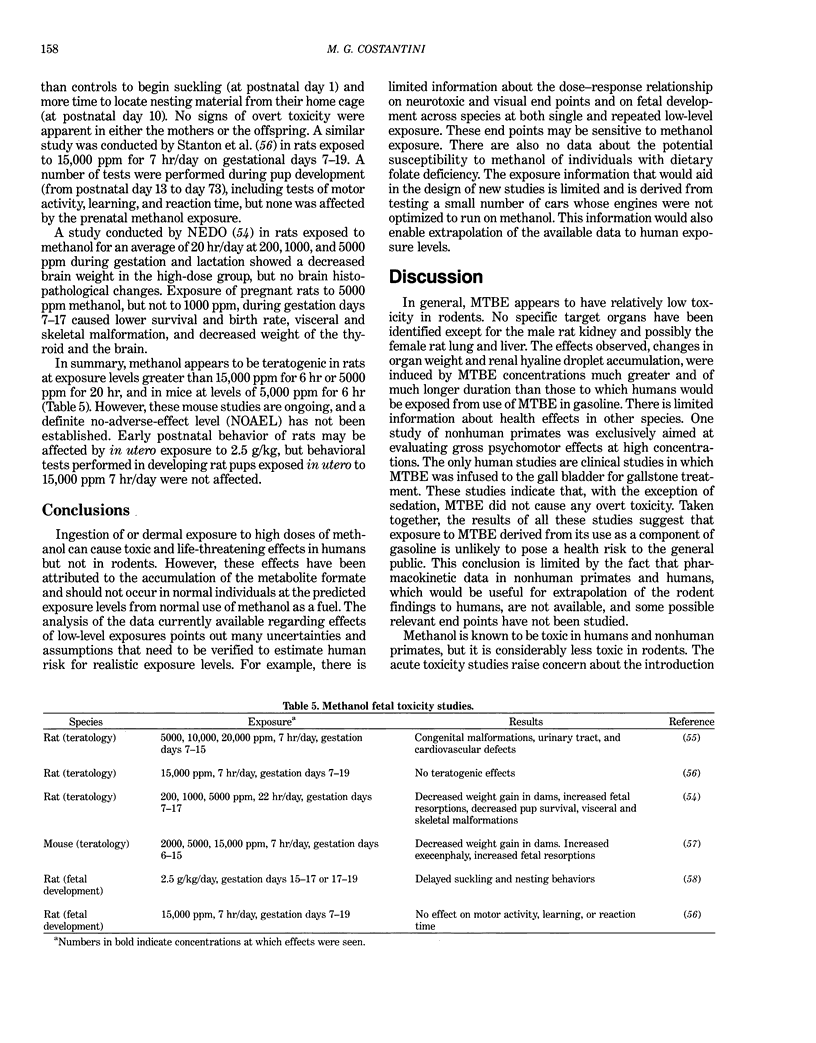
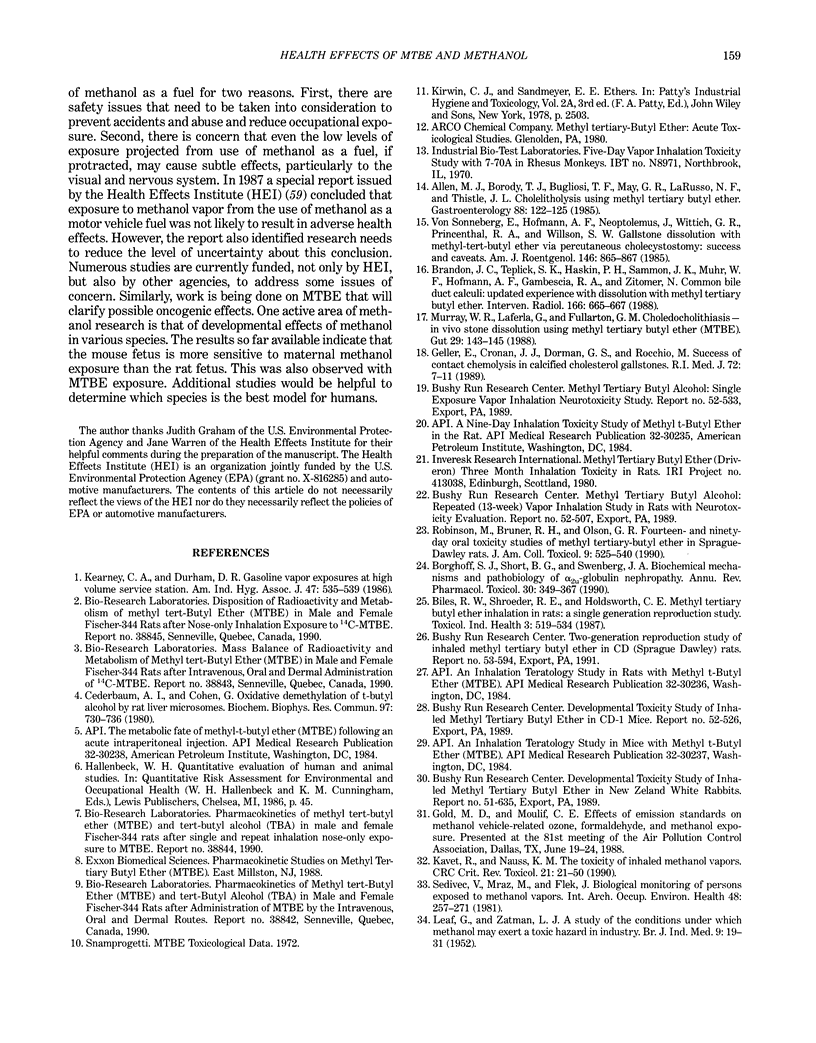
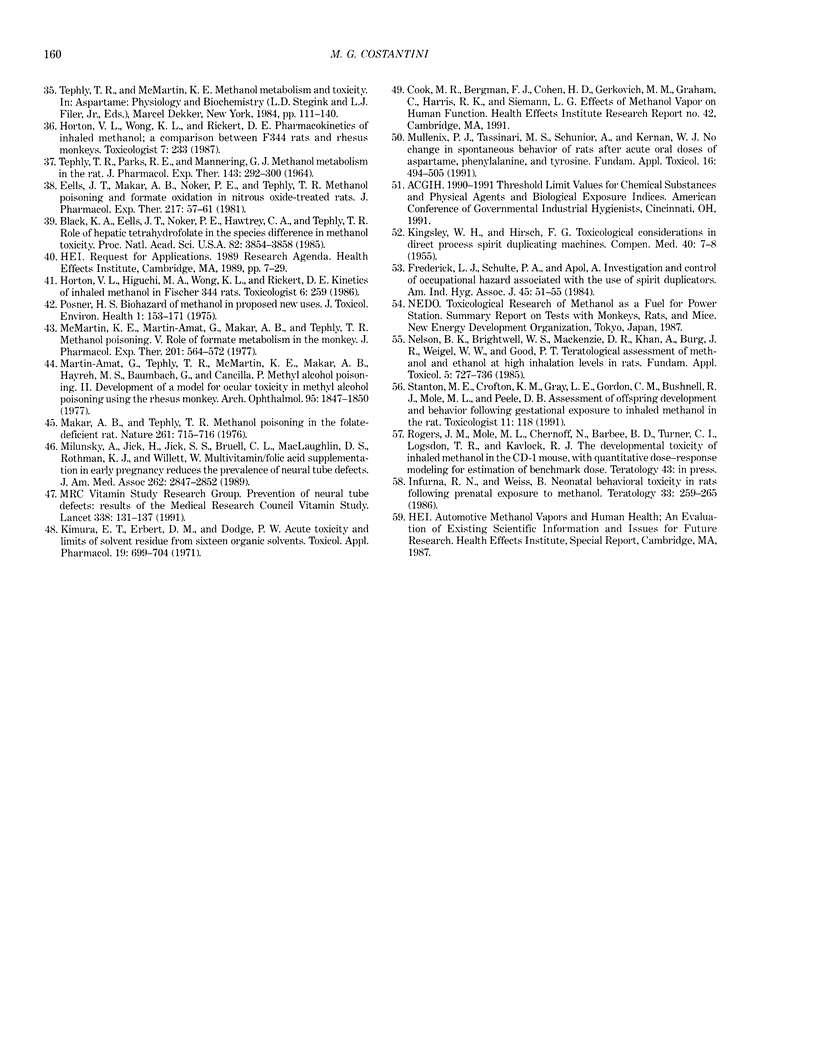
Selected References
These references are in PubMed. This may not be the complete list of references from this article.
- Allen M. J., Borody T. J., Bugliosi T. F., May G. R., LaRusso N. F., Thistle J. L. Cholelitholysis using methyl tertiary butyl ether. Gastroenterology. 1985 Jan;88(1 Pt 1):122–125. doi: 10.1016/s0016-5085(85)80143-8. [DOI] [PubMed] [Google Scholar]
- Biles R. W., Schroeder R. E., Holdsworth C. E. Methyl tertiary butyl ether inhalation in rats: a single generation reproduction study. Toxicol Ind Health. 1987 Dec;3(4):519–534. doi: 10.1177/074823378700300406. [DOI] [PubMed] [Google Scholar]
- Black K. A., Eells J. T., Noker P. E., Hawtrey C. A., Tephly T. R. Role of hepatic tetrahydrofolate in the species difference in methanol toxicity. Proc Natl Acad Sci U S A. 1985 Jun;82(11):3854–3858. doi: 10.1073/pnas.82.11.3854. [DOI] [PMC free article] [PubMed] [Google Scholar]
- Borghoff S. J., Short B. G., Swenberg J. A. Biochemical mechanisms and pathobiology of alpha 2u-globulin nephropathy. Annu Rev Pharmacol Toxicol. 1990;30:349–367. doi: 10.1146/annurev.pa.30.040190.002025. [DOI] [PubMed] [Google Scholar]
- Brandon J. C., Teplick S. K., Haskin P. H., Sammon J. K., Muhr W. F., Hofmann A. F., Gambescia R. A., Zitomer N. Common bile duct calculi: updated experience with dissolution with methyl tertiary butyl ether. Radiology. 1988 Mar;166(3):665–667. doi: 10.1148/radiology.166.3.3340760. [DOI] [PubMed] [Google Scholar]
- Cederbaum A. I., Cohen G. Oxidative demethylation of t-butyl alcohol by rat liver microsomes. Biochem Biophys Res Commun. 1980 Nov 28;97(2):730–736. doi: 10.1016/0006-291x(80)90325-3. [DOI] [PubMed] [Google Scholar]
- Eells J. T., Makar A. B., Noker P. E., Tephly T. R. Methanol poisoning and formate oxidation in nitrous oxide-treated rats. J Pharmacol Exp Ther. 1981 Apr;217(1):57–61. [PubMed] [Google Scholar]
- Frederick L. J., Schulte P. A., Apol A. Investigation and control of occupational hazards associated with the use of spirit duplicators. Am Ind Hyg Assoc J. 1984 Jan;45(1):51–55. doi: 10.1080/15298668491399361. [DOI] [PubMed] [Google Scholar]
- Geller E., Cronan J. J., Dorman G. S., Rocchio M. Success of contact chemolysis in calcified cholesterol gallstones. R I Med J. 1989 Jan;72(1):7–11. [PubMed] [Google Scholar]
- Infurna R., Weiss B. Neonatal behavioral toxicity in rats following prenatal exposure to methanol. Teratology. 1986 Jun;33(3):259–265. doi: 10.1002/tera.1420330302. [DOI] [PubMed] [Google Scholar]
- Kearney C. A., Dunham D. B. Gasoline vapor exposures at a high volume service station. Am Ind Hyg Assoc J. 1986 Sep;47(9):535–539. doi: 10.1080/15298668691390188. [DOI] [PubMed] [Google Scholar]
- Kimura E. T., Ebert D. M., Dodge P. W. Acute toxicity and limits of solvent residue for sixteen organic solvents. Toxicol Appl Pharmacol. 1971 Aug;19(4):699–704. doi: 10.1016/0041-008x(71)90301-2. [DOI] [PubMed] [Google Scholar]
- LEAF G., ZATMAN L. J. A study of the conditions under which methanol may exert a toxic hazard in industry. Br J Ind Med. 1952 Jan;9(1):19–31. doi: 10.1136/oem.9.1.19. [DOI] [PMC free article] [PubMed] [Google Scholar]
- Makar A. B., Tephly T. R. Methanol poisoning in the folate-deficient rat. Nature. 1976 Jun 24;261(5562):715–716. doi: 10.1038/261715a0. [DOI] [PubMed] [Google Scholar]
- Martin-Amat G., Tephly T. R., McMartin K. E., Makar A. B., Hayreh M. S., Hayreh S. S., Baumbach G., Cancilla P. Methyl alcohol poisoning. II. Development of a model for ocular toxicity in methyl alcohol poisoning using the rhesus monkey. Arch Ophthalmol. 1977 Oct;95(10):1847–1850. doi: 10.1001/archopht.1977.04450100149021. [DOI] [PubMed] [Google Scholar]
- McMartin K. E., Martin-Amat G., Makar A. B., Tephly T. R. Methanol poisoning. V. Role of formate metabolism in the monkey. J Pharmacol Exp Ther. 1977 Jun;201(3):564–572. [PubMed] [Google Scholar]
- Milunsky A., Jick H., Jick S. S., Bruell C. L., MacLaughlin D. S., Rothman K. J., Willett W. Multivitamin/folic acid supplementation in early pregnancy reduces the prevalence of neural tube defects. JAMA. 1989 Nov 24;262(20):2847–2852. doi: 10.1001/jama.262.20.2847. [DOI] [PubMed] [Google Scholar]
- Mullenix P. J., Tassinari M. S., Schunior A., Kernan W. J. No change in spontaneous behavior of rats after acute oral doses of aspartame, phenylalanine, and tyrosine. Fundam Appl Toxicol. 1991 Apr;16(3):495–505. doi: 10.1016/0272-0590(91)90090-q. [DOI] [PubMed] [Google Scholar]
- Murray W. R., LaFerla G., Fullarton G. M. Choledocholithiasis--in vivo stone dissolution using methyl tertiary butyl ether (MTBE). Gut. 1988 Feb;29(2):143–145. doi: 10.1136/gut.29.2.143. [DOI] [PMC free article] [PubMed] [Google Scholar]
- Nelson B. K., Brightwell W. S., MacKenzie D. R., Khan A., Burg J. R., Weigel W. W., Goad P. T. Teratological assessment of methanol and ethanol at high inhalation levels in rats. Fundam Appl Toxicol. 1985 Aug;5(4):727–736. doi: 10.1016/0272-0590(85)90197-6. [DOI] [PubMed] [Google Scholar]
- Sedivec V., Mráz M., Flek J. Biological monitoring of persons exposed to methanol vapours. Int Arch Occup Environ Health. 1981;48(3):257–271. doi: 10.1007/BF00405613. [DOI] [PubMed] [Google Scholar]
- TEPHLY T. R., PARKS R. E., Jr, MANNERING G. J. METHANOL METABOLISM IN THE RAT. J Pharmacol Exp Ther. 1964 Mar;143:292–300. [PubMed] [Google Scholar]
- vanSonnenberg E., Hofmann A. F., Neoptolemus J., Wittich G. R., Princenthal R. A., Willson S. W. Gallstone dissolution with methyl-tert-butyl ether via percutaneous cholecystostomy: success and caveats. AJR Am J Roentgenol. 1986 Apr;146(4):865–867. doi: 10.2214/ajr.146.4.865. [DOI] [PubMed] [Google Scholar]


